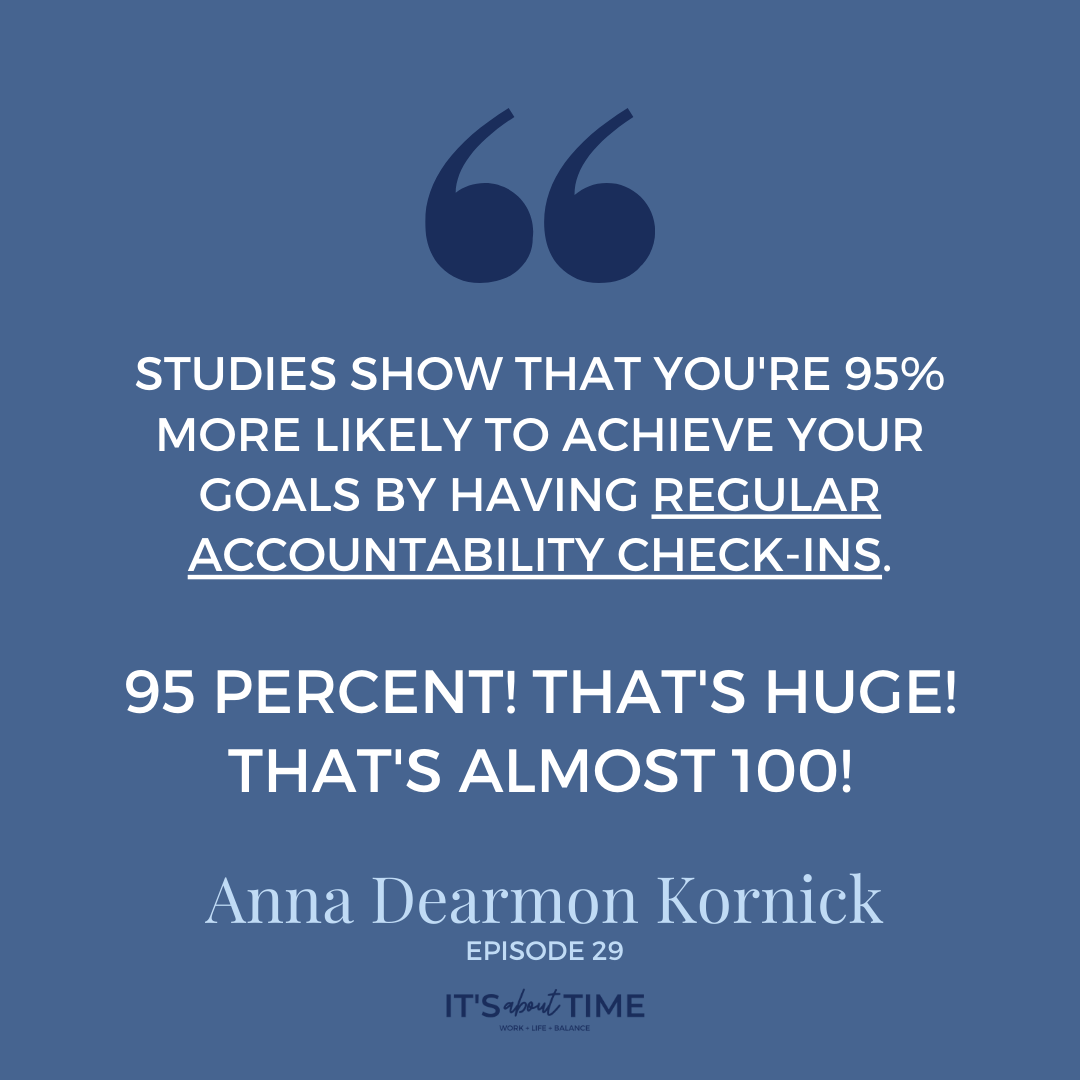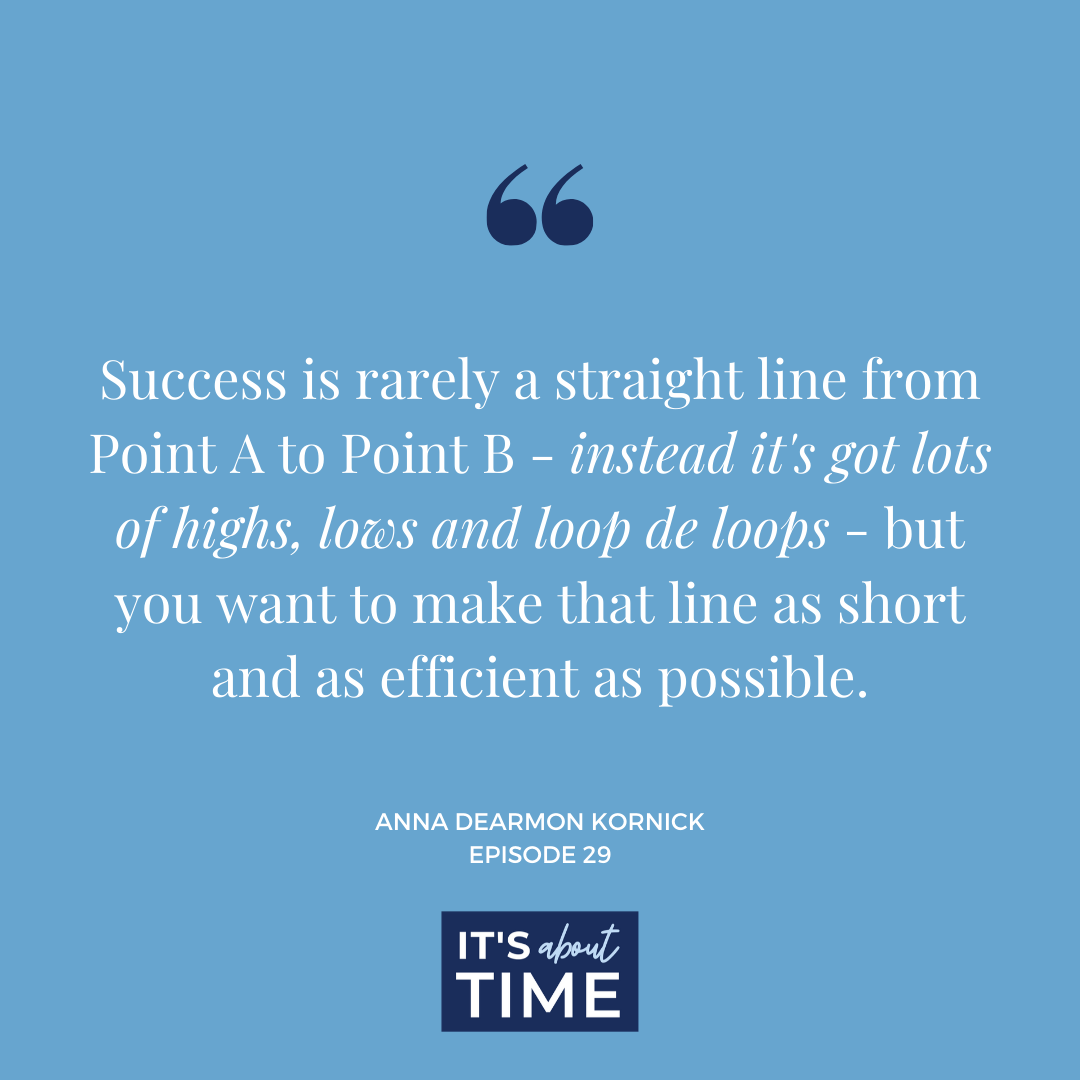LISTEN IN APPLE PODCASTS | LISTEN IN SPOTIFY | LISTEN IN GOOGLE PODCASTS | LISTEN IN STITCHER

Episode 29 of It’s About Time is all about getting YOU where you want to go.
And I’m not talking planes, trains or automobiles – even though I sure could use a vacation right about now.
Nope – in this episode I’m talking about the absolute, number one, most important ingredient required in order to achieve whatever dream, goal, project or plan is on your mind.
And before I tell you what it is, I want you to take a sec and think about that dream, goal, project or plan.
Ok – Got it?
Now I invite you to picture yourself on the other side of it. You’ve got your success, you’ve reached the finish line and it feels amazing.

Now – let’s talk about that key ingredient to getting there.
It’s called accountability.
In this episode, I’ve created a comprehensive guide to accountability, including:
-
Why having accountability is such an important part of your road to success
-
What an accountability set up can look like, answering the questions Who should you partner with, and how often should you meet.
-
Then – I’ll dive into 5 different options you can pursue to get the accountability you need to reach your goals, weighing the pros and cons for each.
-
You’ll walk way with ideas and inspiration for finding accountability to reach YOUR big goal, so you can have – in real life – that success you just pictured a few moments ago.
if you’re listening to this episode, there’s one thing I know about you – and it’s that you value your time. And if you value your time, you want to get the most bang for your buck when it comes to time spent on achieving whatever it is you’ve set your mind to.
Whether that’s getting in shape, getting a promotion, getting a new job, getting your masters or PHD or getting to the next level in your business.
You want to get there, and although success is rarely a straight line from point A to point B – instead it’s often got lots of highs, lows and loop de loops – but you want to make that line from Point A to Point B as short and efficient as possible.
You get there with a clear vision for the future.
You get there with a plan of action.
And you get there with accountability.
WHY Accountability is such a big deal.

First – let me tell you why having accountability is such an important part of your road to success.
Got a pen? Because studies show that you are 42% more likely to achieve your goals by writing them down. Which is great!
But let’s take it one step further.
Got a friend? Because studies show that you are 65% more likely to achieve your goals by committing to someone. That’s a pretty good increase just by telling someone that you’ve set a goal.
But again – let’s take it one step further.
Got an accountability partner? Because studies show that you are 95% more likely to achieve your goals by having regular accountability check-ins in with someone.
95. 95 percent! That’s huge! That’s almost 100!
So knowing that by sharing your goal with someone and setting up regular check-ins almost guarantees your success – why wouldn’t you take that step?
WHAT Accountability can look like
Alright – now that you’re convinced and super excited about incorporating an element of accountability into your current endeavors, let’s talk about what accountability can look like.
Basically the most critical piece of the accountability partner equation is less about the WHO and more about the WHEN.
And the when – just has to be regular – or defined. This could look like every day – every week – every other week – any interval that makes sense for your goal.
For example – if you’re struggling to start your day with a morning routine that makes time for personal development and fitness – it could make sense to create an agreement with an accountability partner in which you send them a text of your feet on the floor, or in your running shoes, or a selfie by the coffee pot before 6AM.
If you’re working on a new product in your business, and you’ve mapped out our plan of action – checking in with an accountability partner every Monday to share what’s on your plate for the week ahead, and then again on Friday to share your progress could be a good routine.
Regardless of how often you choose to check-in, what’s most important is that it’s regular, recurring and agreed upon in advance.
SIX Ways to Get Accountability and REACH YOUR GOALS

So now let’s take a look at the different options you can access in order to incorporate regular accountability into your current goal setting, and goal reaching!
I’ll tell you about each type of accountability, and the pros and cons associated with each so you’ll have everything you need to decide where to go from here when choosing your accountability.
Three one on one options
-
Finding an accountability partner
-
Learning from a Mentor
-
Working a coach
And three group options
-
Joining a membership
-
Participating in group coaching
-
Joining (or starting) a mastermind group
1. Find an Accountability Partner
First – I can’t believe we’re this far into an episode about accountability and I’m just now saying Accountabili-buddy
Finding an accountability partner – or accountabili-buddy is usually our first thought when it comes to creating accountability for our goals. It’s simple finding a friend, family member, colleague, maybe your significant other other and asking them to keep you accountable to a goal you’ve set.
This can take two different forms. The accountability can be one-way or two way.
-
One-way meaning you’re the only person working toward a goal, and your partner is keeping you accountable, or
-
Two-way in which you’re both keeping each other accountable to the same, or possibly different goals.
AWESOME ADVANTAGES
A few advantages to having an accountability partner.
First of all, they’re free. And if you ask a family member or friend, they care about you and your success, so they’ll do their best to hold you to your commitments. Additionally, we often don’t like to let down those we care about, so we’ll be more likely to stick to our commitments if we know that someone is counting on us.
Second – you have the opportunity to strengthen a relationship with a peer by sharing a behind the scenes look at your progress. If you’re growing your business alongside another business owner, sharing the good and the bad puts things into perspective and your vulnerability helps you grow as a person and a business owner.
By forming an accountability partnership with another professional in your industry, you can navigate leadership challenges together and treat one another as confidantes as you’re solving problems.
And plus – running, learning how to cook, making pottery, whatever your pursuit – it’s just more fun with a buddy.
POTENTIAL PITFALLS
But there are a few downsides.
Free accountability partnerships – a friend or family member – are typically not as formal. And because the consequences are usually low, it can be easier to brush off your commitments.
A few years ago, my husband Scott and I were supposed to hold each other accountable to getting up before work to do our half-marathon training runs, but more often than not, we’d hit the snooze button, quickly agree that we’d try to get in our training run after work (which more often than not, we skipped). So that was a bit of a fail.
I also started Friday emails with an accountability partner back in January/February, and our Friday emails were in a great groove until the coronavirus craziness stepped in and got us off our game.
One last potential pitfall to mention – if you an your accountability partner are at different levels of whatever it is you’re doing together. So let’s say you’re a business owner, and you form an accountability partnership with someone who is newer to the business world. Your partnership may unintentionally evolve into a mentorship, in which one participant gets way more out of it than the other. This can leave the buddy who accidentally became the mentor feeling slighted because they’re doing all the helping, and that’s not what they were hoping to get out of the partnership.
Same pitfall applied to fitness, if your accountability is running a 5 minute mile, and you just started Couch to 5K, you might get discouraged by your partner’s speed and give up when you can’t keep up.
So – Accountability partners – great because they’re free. Downsides are the lack of formality, and potential for a mismatch in levels.
2. Learn from a Mentor
Your next one-on-one option is working with a Mentor. I wish I could get a show of hands to see who in the audience has a professional mentor. I personally do not have a professional mentor, so if there are any seasoned coaches or professional speakers reading this that would like to mentor me – send me an email!
A mentor is typically someone in your industry or someone who understands your work. This person is traditionally older, or more established in their career. Many companies and some professional associations offer mentor matching programs. With a mentor, you have the ability to learn from their experience, and they have the opportunity to learn from you as a younger professional.
An example for me – I’m a time management coach, speaker and podcaster. While it’s not necessary that I be mentored by an actual Time Management Coach, someone who has an established career as a business coach or life coach, or is a veteran professional speaker would be a great fit.
What would a professional mentor look like for you? Would it make sense to work with someone in your industry, or with your same job title? Or could you go beyond your specific niche to find a mentor and still enjoy the benefits?
AWESOME ADVANTAGES
The perks to working with a mentor? The relationship is typically free, although some matching programs might require a fee. You have the opportunity to learn from someone who is more seasoned in their career while also committing your goals to them for accountability. Working with a mentor usually comes with more structure than an accountability partner, but not always. Sometimes that structure is dictated by the mentorship program sponsored by the company or organization, and sometimes that structure is created by the mentor/mentee pair.
POTENTIAL PITFALLS
A few cons – If your industry has seen drastic changes and there’s an old guard and new guard that share different philosophies on how things should be done, your mentor may not understand or agree with innovations within your industry. This can make conversation and relating to one another difficult. If you participate in a matching program and you don’t click with your mentor, that can hinder your relationship, your consistency and your progress toward your goals. Another point to make regarding consistency, since the Mentor is typically a seasoned professional, that can mean that you’re navigating a busy, in-demand schedule in order to get critical face-time with your mentor.
So – Working with a mentor. Sometimes free, sometimes not. Sometimes structure, sometimes not. Finding a good fit with a consistent meeting time is your best bet.

3. Working with a Coach
The third one-on-one option is working with a coach. Working with a coach can take a few different forms, and the most important thing to note is that a coach has typically been trained in the process of asking thoughtful questions in order to uncover limiting beliefs and reveal new possibilities.
To put it in the words of the ICF – the International Coaching Federation, coaching is partnering with clients in a thought-provoking and creative process that inspires them to maximize their personal and professional potential.
Coaches understand how to sift through disorganized thoughts that might seem all over the place and help their client distill those thoughts into actionable next steps.
There are a lot of different types of coaches. There are more generalized life coaches or success coaches. You could work with a business coach or a health coach. If there’s an industry, a job title or niche that exists, there’s probably a coach for it.
If you’ve been a listener to the podcast for a while, you know that I’m a Time Management Coach, which means that I help my clients – typically professionals and executives or business owners – kick the overwhelm they’re feeling in both work and life through better time management. And – instead of just moving stuff around on a google calendar or helping someone pick a great paper planner, I help my clients craft a vision for their future, and design their days and weeks in order to make that vision a reality, creating sustainable systems and building good habits along the way.
And while some coaches only serve a specific niche or industry, my clients represent a number of industries. Just in the last year I’ve worked with clients in
-
governmental relations
-
nonprofit fundraising and development
-
wedding and corporate event planning
-
event decor rental
-
marketing and PR
-
engineering
-
blogging
-
hospitality marketing and e-commerce
-
nursing, and
-
pharmaceutical sales.
AWESOME ADVANTAGES
The pros of working with a coach include
-
Structure. 9 times out of 10, you’ll meet with your coach on a regular basis, and your coach will come to each of your sessions with a plan in mind. I meet with my coaching clients for an hour every other week, and do an accountability check-in between each session. Some coaches meet weekly, others monthly.
-
In addition to structure, a good coach will make sure that each coaching session ends with clear next steps and a plan for creating accountability. Sometimes I take that accountability one step further and ask my client to tell me what might get in the way of their ability to follow through on their next steps in order to identify potential obstacles and overcome them in advance.
-
Long-term consistency – if you’re playing the long game on a goal, something that will take several months – or maybe even years to achieve, working with a coach is the way to go. A good coach will consistently push you and help you stay focused on your long term goal, and help you identify fresh perspectives and root out limiting beliefs that are holding you back along the way. You create a history with your coach.
-
Coaches also serve as an unbiased sounding board. It can be tough for a friend, loved one or coworker to bring an unbiased perspective to a challenge you’re facing. They just can’t help it. The unbiased nature of a coach means they can help you see all sides of a challenge and help you find creative solutions for moving forward.
-
Working with a coach is typically an investment, although that investment can vary from coach to coach. There’s a saying that goes, “The transformation is in the transaction.” Because you’ve made an investment, you tend to take your commitment – whether that’s your commitment to your health, to your business, your career or your personal life, much more seriously. And when you take your commitment seriously, you create the results you were hoping for.
POTENTIAL PITFALLS
So let me tell you the downsides to working with a coach:
First of all – unlike an accountabili-buddy – it’s not free, and it can be a substantial investment depending on the coach. According to lifecoach.com, most life coaches working with individuals charge about $200 to $1000 per month, executive coaching and corporate coaching can cost from $1000 to $10,000. These monthly fees can include all kinds of additional services – like unlimited texting or voice chats between calls, access to course libraries, personality assessments, in-person treats, and all kinds of other things.
Next downside – most coaching packages last a minimum of 3 months, and many are at least 6 months long. True transformation takes time, so if you’re looking for a quick burst of accountability over a short period of time, a coach wouldn’t be a good fit for you. That doesn’t mean you won’t see results right away – you’ll typically begin to see results right after your first session – but achieving any long-term goal takes time.
Another potential downside – if you realize that you and your coach are not necessarily a good fit, and that your styles don’t mesh well – you may not get the results you’re hoping for. If you’re considering working with a coach to get the accountability you need to push a long-term project or make your vision come to life, take time to get to know your coach before you make a 6 month or longer commitment.
I give anyone interested in working with me an entire hour-long coaching session, for free, before we start working together officially in order to ensure that we’re a good fit for each other because it’s such an important part of building trust in a coaching relationship.
So – working with a coach one on one:
Pros: structure, clear next steps, unbiased sounding board, long-term consistency, and you take the commitment seriously because of the investment. Cons: it’s not free, it’s a marathon, not a sprint, and not meshing well could impede your progress
Now that we’ve covered three one-on-one opportunities to create accountability – finding an accountability partner, learning from a mentor and working with a coach, let’s look at three ways to get accountability in a group setting: joining a membership, participating in group coaching and joining a mastermind group.
4. Join a membership program.
First – Let me tell you about memberships.
A membership is a group of individuals, led by a coach or business owner that provides recurring education on a specific theme. Often, memberships have a low-cost, monthly subscription or membership fee that grants the member access to a members portal with course materials, videos, live workshop trainings and a private, members only facebook group.
Accountability is created by showing up in the facebook group, watching and participating in the live training workshops. Sometimes memberships will offer accountability partner matching, or the leader might curate small accountability groups within the larger group.
For example – I’m a member of Kristin Brabant’s Solopreneurs Circle, a membership group for female sole proprietors from different industries. Each month, Kristin hosts a live training on a topic relevant to our challenges as solo business owner, or she brings in a guest expert on a particular topic. A few months ago, I gave a Guest Expert presentation on how to be the visionary in your business by automating, delegating and eliminating things on your to do list.
I don’t have a membership as a part of my service offerings – but if I were to start one it might look like this…
-
I’d host live, but recorded, monthly workshops on different topics on work, life and balance – basically things that would help you get your life together. From how to finally organize your photos and how to start meal planning, to the step-by-step for creating routines and building sustainable habits.
-
I’d offer bonus workshops on career and business topics like social media marketing or organizing your google drive, and
-
I’d bring in guest experts like a professional organizer or an event planner to help you get your pantry in tip-top shape and plan your first non-socially distanced soiree.
-
Plus a private facebook group to share tips and celebrate wins.
AWESOME ADVANTAGES
Pros to Memberships? They’re often an inexpensive monthly investment. Ranging from $29 to $97 dollars a month. It just depends on the group and what exactly it offers. You typically get access to a good bit of educational content that you can take in at your convenience. You also have the potential to meet new people and create new connections in the private members group.
POTENTIAL PITFALLS
The downside is that you usually don’t get much, if any 1:1 time with the coach or the leader. Any connection with the leader happens in the live trainings, live Q&A sessions in the facebook group or via the comments in the facebook group. It’s also a recurring monthly investment instead of a one time thing. The structure is found in the monthly trainings, but unless there’s a matching program, you’ll have to find your own accountability partner within the members.
In a nutshell – a membership is a low-cost, but low-touch structure accountability option. It’s great for learning through the trainings and course materials, expanding your network and honestly – they’re just a lot of fun. I love jumping into the facebook groups for the memberships that I’m a part of and cheering on the other members as they’re making moves in their business.
5. Participate in a Group Coaching Program
The next group accountability option is Group coaching.
Just like with regular coaching – group coaching can take a lot of different forms. In its most basic form, group coaching consists of a group of individuals with the same or similar goals meeting at regular intervals under the leadership and guidance of a coach.
Sometimes the coaching sessions feature a specific theme or topic, building on each other week to week. While there are many different ways to structure a group coaching session, they typically begin with a lesson from the coach, then the floor is opened up for questions and problem solving. Members may have an opportunity to be coached in the session, which the rest of the participants listen in. This is great, because many of the participants share the same challenges, so even if you’re not directly engaging with the coach, you still have the opportunity to learn from the coaching session and apply what you’ve learned to your unique situation.
For example, my good friend Logan Doerries, CEO of The School of Styling (you might remember Logan from Episode 11 of It’s About Time) recently launched an 8 week group coaching program.
The School of Styling is known for its gorgeously curated in-person educational retreats for creative entrepreneurs. During the pandemic, Logan pivoted The School of Styling’s business model and created a virtual way to connect and coach creative business owners from across the country.
In The School of Styling’s Homeschool Group Coaching Program, participants meet virtually for 8 weeks – each week focusing on a different topic relevant to their industry. From goal setting and personal growth to productivity and social media, they’ll hear from subject matter experts and learn from each other in intimate group discussions. In fact, I’m pretty excited to coach the group on time management and productivity next week. Plus they’re offered a weekly opportunity to talk with Logan, the CEO via a Facebook live in a private members-only group.
Even though they aren’t working with Logan one-on-one, they’re still making major progress toward their business goals, making new friends and they have structured, weekly accountability built in.
This past spring, I led a group coaching experience with four graduating seniors and members of the Broom Student Fellows at San Diego State University. Our sessions – every other week – kicked off with ice breaker questions, a book club style discussion of a time management and career focused book, and a hot seat coaching session that solved a time management challenge for one of the fellows.
AWESOME ADVANTAGES
Pros of group coaching – There are typically regularly scheduled coaching sessions that include the whole group, so there’s structure. The sessions typically follow some sort of curriculum, so you’re learning more about a particular subject. Assignments and clear next steps are common, and you typically have to report back during the next session. You have opportunities to be directly coached by the leader, and you typically develop a relationship with the other members of the group.
I should also mention that the investment associated with group coaching is typically more than a mastermind, but considerably less than working one on one with a coach. If a membership is less than $100 a month, a group coaching program is typically priced in the $400-1500 range (for the whole program) depending on the program’s length and content. 8 weeks is pretty typical.
POTENTIAL PITFALLS
Cons of group coaching – While there’s definitely more opportunity for 1 on 1 engagement with the coach during a group coaching program than in a membership setting, you aren’t guaranteed that one-on-one engagement for each and every session – especially if the group is large. I’ve led a group coaching program for 5 individuals, and I’ve been a part of group coaching programs with hundreds of members.
If you’re considering a group coaching program, pay attention to the size of the group. With a large group that includes hundreds of members, it’s easy to feel disengaged and lost in the crowd. That can result in a lower commitment level to following through with your action steps because it can feel like no one is watching or paying attention.
Ok – Group coaching recap: Pros are – that it’s a mid-range investment option compared to membership and private coaching, shorter commitment than most 1:1 coaching programs, typically focuses on a specific topic, is usually structured and meets on a recurring basis which are key elements of accountability. It can include educational resources and other bonus learning opportunities. Cons are that you get some, but not much individualized time with the leader, and if the group is too large, you can get lost.
6. Join (or start) a Mastermind Group
Finally – the last group accountability option I want to share with you in this episode is joining a mastermind group.
Sidenote: just love the word mastermind. I don’t know why but it makes me think of Sherlock Holmes.
A mastermind group can combine nearly everything we’ve talked about so far, but pumps it up to level 10 and throws in live events, retreats and all kinds of other things.
Just like all of the other options, a mastermind group can take many forms, but at its most basic level it’s a small group of individuals – typically between 5-20 – who meet on a regular basis, typically virtually or via conference call – and follow a specific agenda during each meeting that is facilitated by a single group leader, or each member rotates their turn as the group leader. The agenda can include deep dive, focused problem solving sessions for each group member, or the whole meeting can be a single, focused, problem solving session for just one member of the group. During each member’s turn in the hot seat the group intensely works to come up with creative ideas through collective brainstorming.
Masterminds can meet as regularly as once a week, twice a month or monthly, but they always have an agenda. Without a doubt, masterminds are the most structured of the group accountability options with set dates, and the expectation that you share the good and the bad, and that you report back after implementation.
Many mastermind groups require you to commit for a minimum of six months, and most last an entire year. This long-term commitment and consistency, combined with the vulnerability of deep dive group problem solving, fosters deep connection among the group members.
Often, mastermind groups that are led by an individual include annual, bi-annual or quarterly in-person meetups, either in the form of conferences, retreats or planning weekends.
The mastermind members typically stay in close touch between meetings, either sharing a Slack channel, a group text or a private, members-only Facebook group.
Mastermind group members are typically highly curated by the person or people leading the group to ensure that there’s a good mix of personalities, industries, perspectives or whatever the group is trying to achieve.
For example – two business owners, who both own event decor rental services, that serve the same exact geographical territory, may not feel comfortable opening up about their business challenges in front of each other – because technically they’re competition, right?
But – if you put one of those event decor rental service owners in a mastermind with a calligrapher, a personal trainer, a wedding planner and a food blogger – they’ll likely feel more comfortable airing their dirty laundry and throwing the red meat on the table to get creative solutions to their problems.
And – the cool thing about all of those different industries in one mastermind is that they bring fresh perspectives and new angles that you may not have thought of because you’re “in the bubble” of your work.
Here’s the really cool thing – a mastermind can be totally free. But it can also be a pretty substantial investment – it all depends on who is leading it.
In a peer-led mastermind group, you can literally just say, I want to start a mastermind. Find some people, create an agenda and a schedule, set up a Facebook Group, and rotate who serves as the leader for each meeting.
This past year, I considered starting a peer-led mastermind group with my friend Ciera – a graphic designer, branding and digital marketing strategist. We created our mastermind goals, designed a structure, brainstormed potential members, started working on a schedule. And then I decided it wasn’t the right time for me to make such a long-term commitment. Ciera decided to keep moving forward with it, and I’m so glad she did because now the mastermind group is the highlight of her week.
A paid mastermind, with all the bells and whistles of a group leader, in-person events, retreats and the whole shebang – like I said – could be a substantial investment. Without going down a rabbit hole of research, I know of one mastermind that costs $14,000 for the year, another that costs $30 grand for the year. Paid masterminds usually require an application, some involve a video or some other type of entry that helps the leader curate the group for maximum impact.
So – mastermind pros – high impact, lots of structure, lots of accountability, group problem solving, can be free! Mastermind cons – the paid ones can be a substantial investment.
RECAP
OK! So – we’ve covered a LOT of options you can pursue to get to 95 – and by that I mean being 95% more likely to achieve your goals.
Three one-on-one options:
-
getting an accountability partner
-
Finding a mentor
-
And working with a coach
And Three group options:
-
Joining a membership
-
Participating in group coaching
-
And joining a mastermind group
They all have pros and cons, they all offer different levels of structure and frequency and they’re all at different price points, but what they all share is a common thread of accountability to help you get where you want to go.
If you’re looking to get to 95% and make major progress in the direction of your goals – I highly encourage you to learn a little more about each option and find the accountability that’s the best fit for you, your life and your vision for the future.
Do you have an accountability partner or work with a coach? Tell me over in the private It’s About Time Facebook community!
I’ve love to hear all about what works for you – or if there’s another kind of accountability I totally missed in this episode. Keep me in line!
Come join us in the It’s About Time Podcast community and tell me!
SUBSCRIBE & REVIEW IN ITUNES
If you’re enjoying It’s About Time so far, I hope you’ll take a moment to subscribe if you haven’t yet – I don’t want you to miss an episode! I’ve got a few bonus episodes in the works, and you might miss them if you’re not subscribed. Click here to subscribe on iTunes.
If really like what you hear, I’d be so grateful if you left me a review over on iTunes, too. Your review play a HUGE role in helping others find out about It’s About Time. And honestly, they’re really fun for me to read! Click here to review, select “Ratings and Reviews” and “Write a Review” and let me know what you’re loving about It’s About Time. Thank you!!
LINKS & RESOURCES MENTIONED IN THIS EPISODE
-
Grab your seat to GET A GAME PLAN: 3 STEPS TO DESIGN YOUR WINNING WEEK
-
Join the Private It’s About Time Podcast Community on Facebook!

Be the first to comment